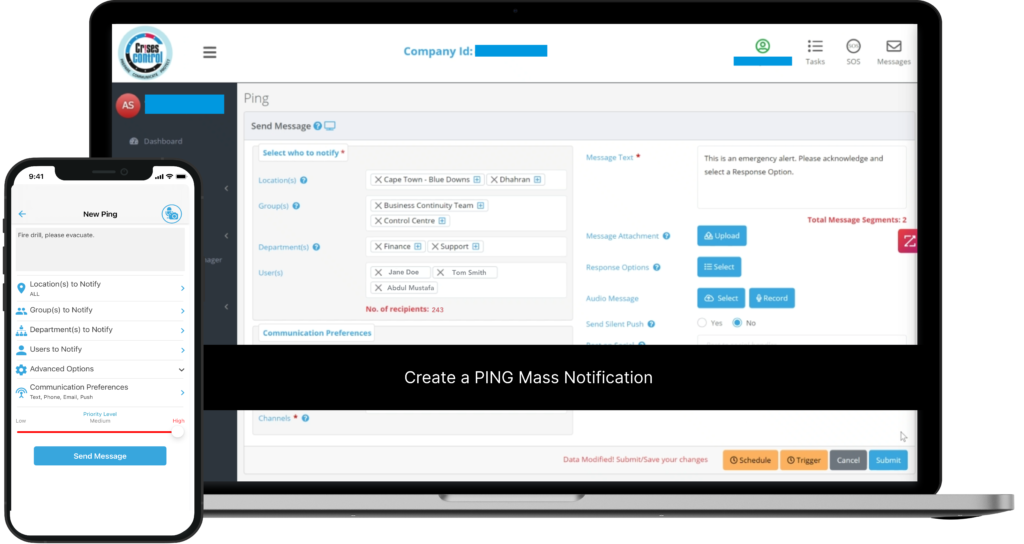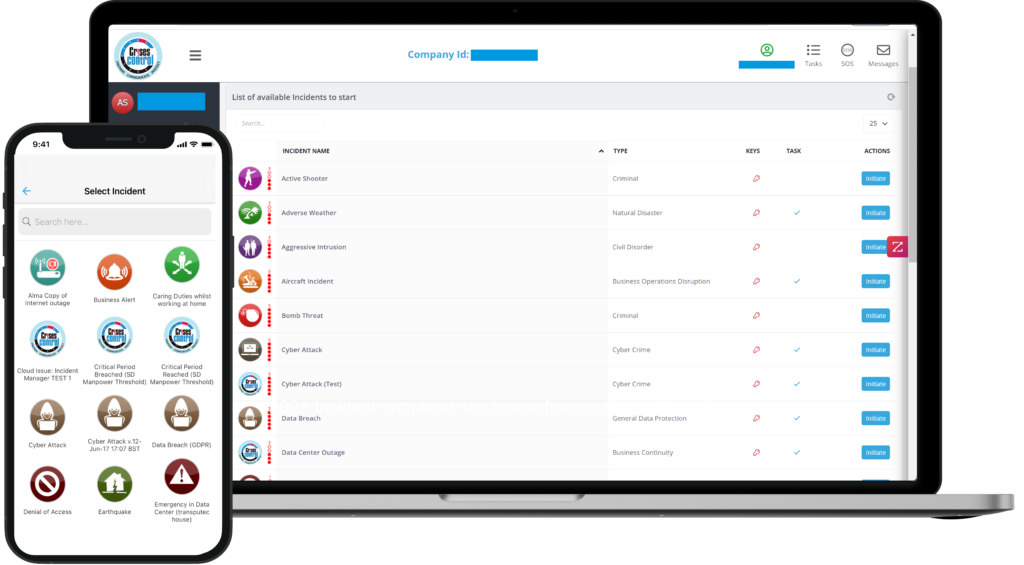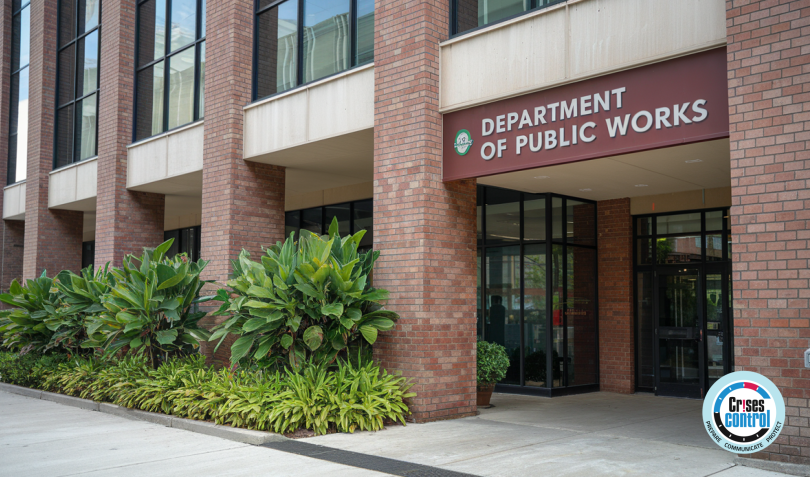Written by Anneri Fourie | Marketing Executive
In an unpredictable world, government agencies are often on the front lines of managing crises, from natural disasters to public health emergencies. During these critical moments, effective communication is essential, but traditional methods like phone calls, emails, and media announcements often fall short. A robust Crisis Communication Platform is no longer just a helpful tool—it’s a necessity for government agencies looking to streamline response efforts, ensure public safety, and maintain order.
This blog will dive into the critical role of crisis communication platforms, the key features that empower government agencies, and why Crises Control stands out as a leader in this field.
The Critical Role of Crisis Communication Platforms for Government Agencies
Government agencies are tasked with responding quickly and effectively during crises, and communication plays a pivotal role in these efforts. A Crisis Communication Platform provides a centralised hub for coordinating response efforts, sending out critical information, and engaging with the public in real time. Without a robust platform, agencies face significant challenges, including miscommunication, delayed responses, and decreased public trust.
Challenges Faced by Government Agencies During Crises
- Fragmented Communication: Traditional methods like emails, phone calls, and public announcements are often siloed, causing delays and gaps in information sharing when every second counts.
- Lack of Real-Time Updates: In fast-paced emergencies, outdated information can hinder decision-making and resource allocation, leading to ineffective responses.
- Public Misinformation: Without a centralised system, agencies struggle to control the narrative, leading to the spread of misinformation and public panic.
Key Features of Crisis Communication Platforms That Empower Government Agencies
A Crisis Communication Platform designed for government agencies must address these challenges with features that enhance efficiency, coordination, and transparency. Here’s how these platforms empower agencies during emergencies:
1. Mass Notification Software for Rapid Alerts
Mass Notification Software is the backbone of any effective crisis communication platform. It enables agencies to send alerts and updates to large groups instantly through multiple channels, including SMS, email, mobile apps, and social media. This multi-channel approach ensures that critical messages reach the intended audience promptly, no matter where they are or what device they use.
Benefits
- Immediate Reach: Alerts can be sent to thousands of recipients within seconds, ensuring that staff, responders, and the public are informed instantly.
- Customisable Alerts: Messages can be tailored to specific groups, such as emergency personnel, local communities, or specific government departments, making communication more relevant and effective.
- Two-Way Communication: Unlike one-way alerts, two-way communication allows the public and responders to provide feedback or request assistance, offering valuable situational awareness during emergencies.
Interested in our Ping Mass Notification Software?
Efficiently alert everyone in seconds at scale with our Mass Notification System – PING, get the message out fast and ensure rapid response and recovery.

2. Real-Time Incident Management and Coordination
In a crisis, every second counts. A platform’s incident management feature acts as a command centre, allowing agencies to monitor ongoing incidents, coordinate response efforts, and track progress in real time. This feature ensures that everyone is on the same page, from first responders to top-level decision-makers.
Benefits
- Centralised Command: All data, communications, and updates are consolidated in one place, providing a comprehensive view of the situation to decision-makers.
- Task Management: Assigning tasks, setting deadlines, and tracking completion becomes seamless, reducing the likelihood of missed steps or duplicated efforts.
- Integration with Other Systems: Effective platforms integrate with existing emergency management tools, enhancing interoperability and making the response process smoother and more efficient.
3. Secure and Reliable Communication Channels
Security is a top priority for government agencies, especially during a crisis. A dedicated Crisis Communication Platform ensures that all communication is secure, protected from unauthorised access, and reliable even when other systems fail.
Benefits
- End-to-End Encryption: This protects sensitive data and ensures that only authorised personnel can access information, keeping critical communications secure.
- High Availability: Platforms like Crises Control operate on independent cloud infrastructures, meaning communication can continue even if other systems go down.
- Data Sovereignty: Government agencies can choose local data hosting, complying with national regulations and keeping sensitive information under their control.
4. Analytics and Reporting for Post-Crisis Evaluation
A Crisis Communication Platform’s role doesn’t end when the immediate crisis is over. Post-crisis, analytics and reporting tools provide insights into what worked well and where improvements are needed, helping agencies refine their strategies for future emergencies.
Benefits
- Incident Reports: Detailed reports allow agencies to review the sequence of events, assess response times, and identify areas for improvement.
- Performance Metrics: Tracking the success of communication efforts helps measure engagement rates, pinpoint gaps, and optimise future responses.
- Continuous Improvement: Data-driven insights enable agencies to adjust their emergency plans and communication strategies, enhancing overall preparedness.
How Crises Control Empowers Government Agencies
Crises Control is a leading Crisis Communication Platform that provides government agencies with the tools they need to manage emergencies effectively. Here’s how Crises Control sets itself apart:
- Ping Mass Notification: Crises Control’s Ping Mass Notification feature allows agencies to send alerts across multiple channels instantly. Whether it’s an urgent message to first responders or a public alert to citizens, Ping ensures that communication is swift and reliable.
- Incident Management: The platform’s Incident Manager module acts as a centralised hub for coordinating response efforts. From setting up action plans to tracking task completion, Crises Control simplifies the management of complex crises.
- SOS Panic Button: The SOS Panic Button is a unique feature that enables field personnel to send distress signals with their location, enhancing situational awareness and response efforts during critical moments.
- Reporting and Audit: Crises Control offers robust analytics and reporting tools that help agencies evaluate their response performance, identify strengths, and pinpoint areas for improvement.
- 24/7 Availability and Cloud Infrastructure: Unlike platforms that rely on third-party services, Crises Control operates on its cloud infrastructure, ensuring that communication remains operational even when other systems fail.

Interested in our Incident Management Software?
Customise your Crisis Incident Management Software to meet your specific needs with our flexible tools & stay connected and informed during the crisis and incident management process
Conclusion: Empower Your Agency with Crises Control
Crisis communication platforms are essential tools for government agencies, providing the structure, speed, and security needed to manage emergencies effectively. By adopting a platform like Crises Control, agencies can enhance their response efforts, ensure public safety, and build trust through transparent communication.
Ready to see how Crises Control can empower your agency? Don’t wait—schedule your free personalised demo today and experience the difference that a robust crisis communication platform can make in your emergency response strategy.
Request a FREE Demo

